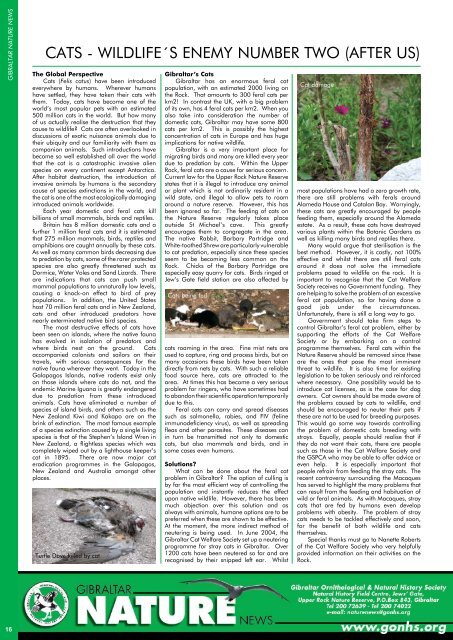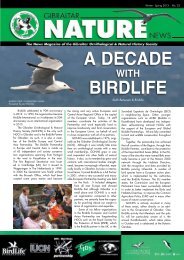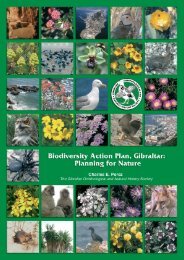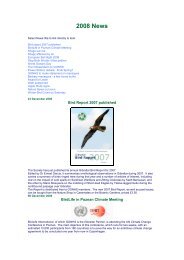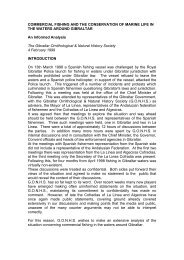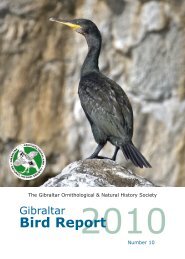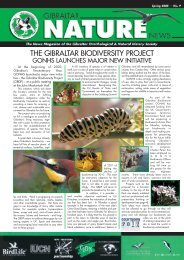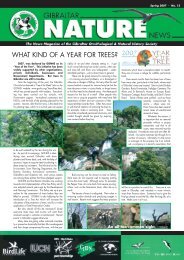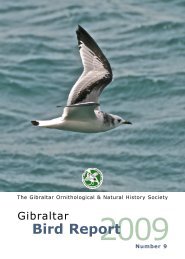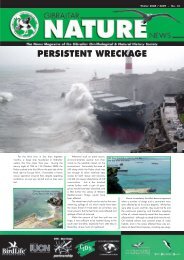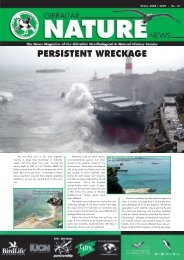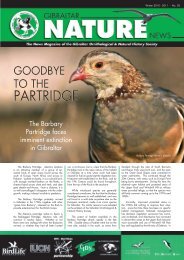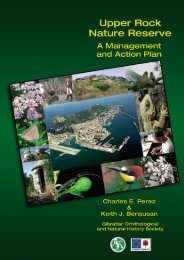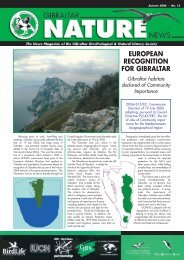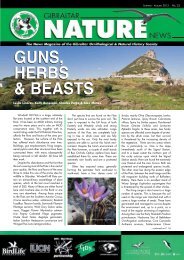No.15 - Gibraltar Ornithological & Natural History Society
No.15 - Gibraltar Ornithological & Natural History Society
No.15 - Gibraltar Ornithological & Natural History Society
Create successful ePaper yourself
Turn your PDF publications into a flip-book with our unique Google optimized e-Paper software.
GIBRALTAR NATURE NEWS<br />
16<br />
CATS - WILDLIFE´S ENEMY NUMBER TWO (AFTER US)<br />
the Global Perspective<br />
Cats (Felis catus) have been introduced<br />
everywhere by humans. Wherever humans<br />
have settled, they have taken their cats with<br />
them. Today, cats have become one of the<br />
world’s most popular pets with an estimated<br />
500 million cats in the world. But how many<br />
of us actually realise the destruction that they<br />
cause to wildlife? Cats are often overlooked in<br />
discussions of exotic nuisance animals due to<br />
their ubiquity and our familiarity with them as<br />
companion animals. Such introductions have<br />
become so well established all over the world<br />
that the cat is a catastrophic invasive alien<br />
species on every continent except Antarctica.<br />
After habitat destruction, the introduction of<br />
invasive animals by humans is the secondary<br />
cause of species extinctions in the world, and<br />
the cat is one of the most ecologically damaging<br />
introduced animals worldwide.<br />
Each year domestic and feral cats kill<br />
billions of small mammals, birds and reptiles.<br />
Britain has 8 million domestic cats and a<br />
further 1 million feral cats and it is estimated<br />
that 275 million mammals, birds, reptiles and<br />
amphibians are caught annually by these cats.<br />
As well as many common birds decreasing due<br />
to predation by cats, some of the rarer protected<br />
species are also greatly threatened such as<br />
Dormice, Water Voles and Sand Lizards. There<br />
are indications that cats can push small<br />
mammal populations to unnaturally low levels,<br />
causing a knock-on effect to bird of prey<br />
populations. In addition, the United States<br />
host 70 million feral cats and in New Zealand,<br />
cats and other introduced predators have<br />
nearly exterminated native bird species.<br />
The most destructive effects of cats have<br />
been seen on islands, where the native fauna<br />
has evolved in isolation of predators and<br />
where birds nest on the ground. Cats<br />
accompanied colonists and sailors on their<br />
travels, with serious consequences for the<br />
native fauna wherever they went. Today in the<br />
Galapagos Islands, native rodents exist only<br />
on those islands where cats do not, and the<br />
endemic Marine Iguana is greatly endangered<br />
due to predation from these introduced<br />
animals. Cats have eliminated a number of<br />
species of island birds, and others such as the<br />
New Zealand Kiwi and Kakapo are on the<br />
brink of extinction. The most famous example<br />
of a species extinction caused by a single living<br />
species is that of the Stephen’s Island Wren in<br />
New Zealand, a flightless species which was<br />
completely wiped out by a lighthouse keeper’s<br />
cat in 1895. There are now major cat<br />
eradication programmes in the Galapagos,<br />
New Zealand and Australia amongst other<br />
places.<br />
Turtle Dove killed by cat<br />
<strong>Gibraltar</strong>’s cats<br />
<strong>Gibraltar</strong> has an enormous feral cat<br />
population, with an estimated 2000 living on<br />
the Rock. That amounts to 300 feral cats per<br />
km2! In contrast the UK, with a big problem<br />
of its own, has 4 feral cats per km2. When you<br />
also take into consideration the number of<br />
domestic cats, <strong>Gibraltar</strong> may have some 800<br />
cats per km2. This is possibly the highest<br />
concentration of cats in Europe and has huge<br />
implications for native wildlife.<br />
<strong>Gibraltar</strong> is a very important place for<br />
migrating birds and many are killed every year<br />
due to predation by cats. Within the Upper<br />
Rock, feral cats are a cause for serious concern.<br />
Current law for the Upper Rock Nature Reserve<br />
states that it is illegal to introduce any animal<br />
or plant which is not ordinarily resident in a<br />
wild state, and illegal to allow pets to roam<br />
around a nature reserve. However, this has<br />
been ignored so far. The feeding of cats on<br />
the Nature Reserve regularly takes place<br />
outside St Michael’s cave. This greatly<br />
encourages them to congregate in the area.<br />
The native Rabbit, Barbary Partridge and<br />
White-toothed Shrew are particularly vulnerable<br />
to cat predation, especially since these species<br />
seem to be becoming less common on the<br />
Rock. Chicks of the Barbary Partridge are<br />
especially easy quarry for cats. Birds ringed at<br />
Jew’s Gate field station are also affected by<br />
Cats being fed<br />
cats roaming in the area. Fine mist nets are<br />
used to capture, ring and process birds, but on<br />
many occasions these birds have been taken<br />
directly from nets by cats. With such a reliable<br />
food source here, cats are attracted to the<br />
area. At times this has become a very serious<br />
problem for ringers, who have sometimes had<br />
to abandon their scientific operation temporarily<br />
due to this.<br />
Feral cats can carry and spread diseases<br />
such as salmonella, rabies, and FIV (feline<br />
immunodeficiency virus), as well as spreading<br />
fleas and other parasites. These diseases can<br />
in turn be transmitted not only to domestic<br />
cats, but also mammals and birds, and in<br />
some cases even humans.<br />
solutions?<br />
What can be done about the feral cat<br />
problem in <strong>Gibraltar</strong>? The option of culling is<br />
by far the most efficient way of controlling the<br />
population and instantly reduces the effect<br />
upon native wildlife. However, there has been<br />
much objection over this solution and as<br />
always with animals, humane options are to be<br />
preferred when these are shown to be effective.<br />
At the moment, the more indirect method of<br />
neutering is being used. In June 2004, the<br />
<strong>Gibraltar</strong> Cat Welfare <strong>Society</strong> set up a neutering<br />
programme for stray cats in <strong>Gibraltar</strong>. Over<br />
1200 cats have been neutered so far and are<br />
recognised by their snipped left ear. Whilst<br />
Cat damage<br />
most populations have had a zero growth rate,<br />
there are still problems with ferals around<br />
Alameda House and Catalan Bay. Worryingly,<br />
these cats are greatly encouraged by people<br />
feeding them, especially around the Alameda<br />
estate. As a result, these cats have destroyed<br />
various plants within the Botanic Gardens as<br />
well as killing many birds and reptiles there.<br />
Many would argue that sterilisation is the<br />
best method. However, it is costly, not 100%<br />
effective and whilst there are still feral cats<br />
around it does not solve the immediate<br />
problems posed to wildlife on the rock. It is<br />
important to recognise that the Cat Welfare<br />
<strong>Society</strong> receives no Government funding. They<br />
are helping to solve the problem of an excessive<br />
feral cat population, so far having done a<br />
good job under the circumstances.<br />
Unfortunately, there is still a long way to go.<br />
Government should take firm steps to<br />
control <strong>Gibraltar</strong>’s feral cat problem, either by<br />
supporting the efforts of the Cat Welfare<br />
<strong>Society</strong> or by embarking on a control<br />
programme themselves. Feral cats within the<br />
Nature Reserve should be removed since these<br />
are the ones that pose the most imminent<br />
threat to wildlife. It is also time for existing<br />
legislation to be taken seriously and reinforced<br />
where necessary. One possibility would be to<br />
introduce cat licenses, as is the case for dog<br />
owners. Cat owners should be made aware of<br />
the problems caused by cats to wildlife, and<br />
should be encouraged to neuter their pets if<br />
these are not to be used for breeding purposes.<br />
This would go some way towards controlling<br />
the problem of domestic cats breeding with<br />
strays. Equally, people should realise that if<br />
they do not want their cats, there are people<br />
such as those in the Cat Welfare <strong>Society</strong> and<br />
the GSPCA who may be able to offer advice or<br />
even help. It is especially important that<br />
people refrain from feeding the stray cats. The<br />
recent controversy surrounding the Macaques<br />
has served to highlight the many problems that<br />
can result from the feeding and habituation of<br />
wild or feral animals. As with Macaques, stray<br />
cats that are fed by humans even develop<br />
problems with obesity. The problem of stray<br />
cats needs to be tackled effectively and soon,<br />
for the benefit of both wildlife and cats<br />
themselves.<br />
Special thanks must go to Nanette Roberts<br />
of the Cat Welfare <strong>Society</strong> who very helpfully<br />
provided information on their activities on the<br />
Rock.


